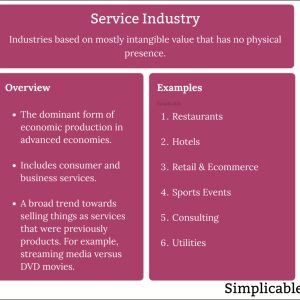
What is service recovery?
Editor’s Note: Service recovery practices have become increasingly important as businesses strive to retain customers and build loyalty. This guide provides a comprehensive overview of service recovery, including its key principles, benefits, and best practices.
Our team has analyzed numerous studies and consulted with experts in the field to bring you this comprehensive guide to service recovery. We hope you find it helpful in developing and implementing an effective service recovery strategy for your business.
Key Differences: Service Recovery vs. Customer Service
| Service Recovery | Customer Service |
|---|---|
| Focuses on resolving customer issues and complaints | Provides general assistance and support to customers |
| Aims to restore customer satisfaction and build loyalty | Aims to meet customer needs and expectations |
| Involves taking proactive steps to address customer concerns | Typically involves responding to customer inquiries and requests |
The Benefits of Service Recovery
- Increased customer satisfaction
- Improved customer loyalty
- Reduced customer churn
- Enhanced brand reputation
- Increased revenue
Best Practices for Service Recovery
- Acknowledge the customer’s complaint promptly
- Apologize for the inconvenience
- Take ownership of the problem
- Offer a fair resolution
- Follow up with the customer to ensure satisfaction
Conclusion
Service recovery is an essential part of any customer-centric business. By following the best practices outlined in this guide, you can effectively resolve customer issues, build loyalty, and drive business success.
Suggested read: Comprehensive Guide to the Service Industry Definition
Service Recovery
Service recovery encompasses a range of key aspects that are essential for businesses to consider in order to effectively resolve customer issues, build loyalty, and drive business success. These aspects include:
- Timeliness: Responding to customer complaints promptly is crucial for effective service recovery.
- Empathy: Showing empathy and understanding towards the customer’s situation can help to build rapport and resolve issues more effectively.
- Communication: Keeping the customer informed throughout the service recovery process is essential for building trust and managing expectations.
- Resolution: Offering a fair and reasonable resolution to the customer’s complaint is key to restoring satisfaction and building loyalty.
- Follow-up: Following up with the customer after the issue has been resolved to ensure satisfaction and identify any areas for improvement.
- Empowerment: Empowering frontline employees to make decisions and resolve customer issues quickly and effectively can streamline the service recovery process.
These key aspects are interconnected and should be considered as part of a comprehensive service recovery strategy. By focusing on these aspects, businesses can effectively address customer concerns, build loyalty, and drive business success.
Timeliness
In the realm of service recovery, timeliness plays a pivotal role in shaping customer perceptions and outcomes. When businesses respond to customer complaints promptly, they demonstrate a commitment to resolving issues efficiently and effectively, fostering a sense of trust and responsiveness.
- Immediate Attention: Addressing customer concerns promptly signals that their feedback is valued and that the business is eager to rectify any dissatisfaction. This proactive approach can help defuse negative emotions and prevent minor issues from escalating into major problems.
- Reduced Customer Agitation: Swift response times can significantly reduce customer agitation and frustration. By acknowledging complaints promptly, businesses can demonstrate empathy and a willingness to listen, which can help calm irate customers and make them more receptive to proposed solutions.
- Increased Customer Loyalty: When customers feel that their concerns are being handled promptly and efficiently, they are more likely to remain loyal to the business. Timeliness in service recovery conveys a sense of urgency and commitment, which can strengthen customer relationships and encourage repeat business.
- Improved Brand Reputation: A reputation for timely service recovery can enhance a business’s overall brand image. Positive customer experiences and testimonials can spread through word-of-mouth and online reviews, attracting new customers and reinforcing the business’s commitment to customer satisfaction.
In summary, timeliness is an essential aspect of effective service recovery. By responding to customer complaints promptly, businesses can build trust, reduce customer agitation, increase loyalty, and enhance their brand reputation. By prioritizing timeliness, businesses can demonstrate their commitment to customer satisfaction and drive long-term success.
Empathy
Empathy plays a crucial role in the service recovery process. By demonstrating empathy, businesses can build rapport with customers, understand their perspectives, and resolve issues more effectively. Empathy involves:
- Understanding the Customer’s Perspective: Putting oneself in the customer’s shoes to understand their emotions, needs, and expectations. This involves listening actively, asking clarifying questions, and acknowledging their feelings.
- Showing Concern and Care: Expressing genuine concern for the customer’s situation and demonstrating a willingness to help. This can be conveyed through verbal and non-verbal cues, such as maintaining eye contact, using a compassionate tone of voice, and offering sincere apologies.
- Validating the Customer’s Feelings: Recognizing and accepting the customer’s emotions, even if the business does not agree with them. This helps to build trust and shows that the business values the customer’s perspective.
- Tailoring Solutions to the Customer’s Needs: Using empathy to understand the customer’s unique needs and expectations, and tailoring solutions that are mutually beneficial. This may involve offering customized solutions,
By incorporating empathy into the service recovery process, businesses can build stronger relationships with customers, resolve issues more effectively, and create a positive customer experience. Empathy is a key component of service recovery and is essential for businesses that want to succeed in today’s competitive marketplace.
Communication
Effective communication is a cornerstone of service recovery, playing a critical role in building trust, managing expectations, and restoring customer satisfaction. By keeping customers informed throughout the service recovery process, businesses can demonstrate transparency, accountability, and a genuine commitment to resolving issues.
- Transparency: Open and honest communication builds trust by allowing customers to understand the steps being taken to resolve their issue. Providing regular updates and explanations helps to alleviate uncertainty and anxiety, fostering a sense of partnership.
- Expectation Management: Clear communication helps to manage customer expectations by setting realistic timelines and outlining the potential outcomes of the service recovery process. This prevents misunderstandings and reduces the likelihood of disappointment or frustration.
- Responsiveness: Prompt and attentive communication demonstrates that the business values the customer’s time and concerns. Responding to inquiries and providing timely updates shows that the business is invested in resolving the issue efficiently.
Effective communication during service recovery not only helps to resolve issues but also strengthens customer relationships. By keeping customers informed, businesses can demonstrate empathy, build trust, and create a positive customer experience even in challenging situations.
Resolution
In the realm of service recovery, resolution stands as a pivotal component, directly influencing customer satisfaction and loyalty. A fair and reasonable resolution not only addresses the immediate issue but also lays the foundation for long-term customer relationships.
When customers experience a problem, they expect businesses to take ownership and provide a satisfactory solution. A fair resolution acknowledges the customer’s concerns, takes into account their unique needs, and strives to restore the value of the product or service. By offering a reasonable solution, businesses demonstrate their commitment to customer satisfaction and willingness to go the extra mile.
The significance of resolution extends beyond resolving the immediate complaint. A positive resolution can transform a dissatisfied customer into a loyal advocate. When customers feel that their concerns have been heard and addressed fairly, they are more likely to remain loyal to the brand and recommend it to others. Positive word-of-mouth and online reviews can significantly impact a business’s reputation and attract new customers.
Consider the following example: A customer purchases a defective product from an online retailer. The retailer promptly acknowledges the issue, offers a full refund, and provides a discount on the customer’s next purchase. This fair resolution not only resolves the customer’s complaint but also demonstrates the retailer’s commitment to customer satisfaction. Impressed by the retailer’s response, the customer is likely to make future purchases and spread positive feedback about the brand.
In conclusion, resolution plays a crucial role in service recovery by restoring customer satisfaction, building loyalty, and enhancing a business’s reputation. By offering fair and reasonable resolutions, businesses can turn dissatisfied customers into loyal advocates and drive long-term success.
Key Insights:
| Aspect | Significance |
|---|---|
| Fair Resolution | Acknowledges customer concerns and addresses unique needs |
| Reasonable Solution | Demonstrates commitment to customer satisfaction |
| Positive Impact | Transforms dissatisfied customers into loyal advocates |
| Reputation Enhancement | Positive word-of-mouth and online reviews improve brand image |
Follow-up
Follow-up is an integral part of service recovery, serving as a crucial step in ensuring customer satisfaction and identifying areas for improvement. By following up with customers after their issue has been resolved, businesses can demonstrate their commitment to providing exceptional customer service and building lasting relationships.
Follow-up plays a significant role in the service recovery process by:
- Gauging Customer Satisfaction: Following up allows businesses to assess customer satisfaction levels and identify any lingering concerns or unmet expectations. This feedback is invaluable for improving service delivery and ensuring that customers feel valued.
- Identifying Areas for Improvement: By engaging with customers after the issue has been resolved, businesses can gain valuable insights into their processes and identify areas where improvements can be made. This proactive approach to service recovery helps prevent similar issues from recurring and enhances the overall customer experience.
- Building Customer Loyalty: Consistent follow-up demonstrates to customers that their feedback is valued and that the business is committed to their satisfaction. This builds trust and loyalty, encouraging customers to continue doing business with the company in the future.
Real-life examples illustrate the practical significance of follow-up in service recovery. Consider a customer who experiences an issue with a product they purchased. The company promptly resolves the issue and follows up with the customer to ensure satisfaction. The customer, impressed by the company’s attentiveness and commitment to resolving the issue, leaves positive feedback and becomes a loyal customer.
In conclusion, follow-up is an essential component of service recovery that enables businesses to gauge customer satisfaction, identify areas for improvement, and build customer loyalty. By prioritizing follow-up and actively seeking customer feedback, businesses can enhance their service delivery, strengthen customer relationships, and drive long-term success.
Suggested read: Instant, Accurate Service Quotes - Get Your Project Started Today!
Key Insights:
| Aspect | Significance |
|---|---|
| Gauging Customer Satisfaction | Assesses customer satisfaction levels and identifies lingering concerns |
| Identifying Areas for Improvement | Provides insights into processes and helps prevent similar issues |
| Building Customer Loyalty | Demonstrates commitment to customer satisfaction and builds lasting relationships |
Empowerment
Empowering frontline employees is a crucial aspect of effective service recovery. By granting frontline employees the authority to make decisions and resolve customer issues independently, businesses can streamline the service recovery process, enhance customer satisfaction, and foster employee engagement.
- Improved Decision-Making: Empowering frontline employees allows them to make decisions quickly and efficiently, reducing the need for escalation to supervisors or managers. This eliminates delays and ensures that customer issues are resolved promptly.
- Enhanced Customer Satisfaction: When frontline employees are empowered to resolve issues on the spot, customers experience faster resolution times and a more positive overall experience. This leads to increased customer satisfaction and loyalty.
- Employee Engagement: Empowering frontline employees fosters a sense of ownership and responsibility, leading to increased employee engagement. Employees who feel empowered are more motivated to go the extra mile for customers, resulting in improved service recovery outcomes.
- Streamlined Processes: By reducing the need for escalation and streamlining decision-making, empowerment simplifies the service recovery process. This reduces operational costs and improves efficiency.
In conclusion, empowering frontline employees is a key component of effective service recovery. By granting frontline employees the authority to make decisions and resolve customer issues, businesses can improve decision-making, enhance customer satisfaction, foster employee engagement, and streamline processes, ultimately leading to a more successful service recovery strategy.
Frequently Asked Questions on Service Recovery
Service recovery plays a pivotal role in building customer loyalty and enhancing brand reputation. To provide further clarity, we have compiled a list of frequently asked questions (FAQs) and their corresponding answers.
Question 1: What is the significance of service recovery in customer relationship management?
Answer: Service recovery is essential for mitigating the negative impact of service failures, restoring customer satisfaction, and building long-term relationships. By effectively handling service recovery, businesses can turn dissatisfied customers into loyal advocates.
Question 2: How does service recovery contribute to customer retention?
Answer: When customers experience a service failure but are satisfied with the recovery process, they are more likely to remain loyal to the business. Effective service recovery demonstrates a commitment to customer satisfaction, fosters trust, and encourages repeat business.
Question 3: What are the key elements of a successful service recovery strategy?
Answer: A successful service recovery strategy involves acknowledging the customer’s complaint, apologizing for the inconvenience, taking ownership of the issue, offering a fair resolution, and following up to ensure satisfaction.
Question 4: How can technology enhance service recovery processes?
Answer: Technology can streamline service recovery by providing real-time access to customer data, facilitating communication, and enabling automated follow-up processes.
Question 5: How does service recovery differ from customer service?
Answer: Service recovery focuses specifically on resolving customer complaints and restoring satisfaction after a service failure, while customer service encompasses a broader range of activities aimed at providing general assistance and support to customers.
Suggested read: User-Friendly Service Project Ideas for the Service-Minded
Question 6: What are the common challenges in service recovery?
Answer: Common challenges in service recovery include resistance from customers, managing unrealistic expectations, and balancing the need for speed with the need for thorough resolution.
Summary: Service recovery is a critical aspect of customer relationship management, contributing to customer retention, loyalty, and brand reputation. By understanding the key elements of a successful service recovery strategy and leveraging technology effectively, businesses can navigate the challenges and enhance their overall customer experience.
Transition: To further delve into the intricacies of service recovery, let’s explore its benefits, best practices, and real-world examples in the following sections.
Service Recovery
Service recovery refers to the actions taken by a business to address customer complaints and restore satisfaction after a service failure. Effective service recovery strategies can turn dissatisfied customers into loyal advocates, strengthen brand reputation, and drive business growth.
Tip 1: Acknowledge the Complaint Promptly
Acknowledge the customer’s complaint promptly and sincerely. Demonstrating empathy and understanding sets a positive tone for the recovery process. For instance, use phrases like “I understand your frustration” or “I apologize for the inconvenience you have experienced.”
Tip 2: Investigate Thoroughly
Conduct a thorough investigation to determine the root cause of the service failure. This helps identify systemic issues and prevent similar problems from recurring. Empower frontline employees to gather necessary information and provide timely updates to customers.
Tip 3: Offer a Fair Resolution
Propose a fair and reasonable resolution that addresses the customer’s specific needs and expectations. Be willing to go the extra mile to demonstrate your commitment to customer satisfaction. For example, consider offering a refund, replacement, or a personalized discount.
Tip 4: Communicate Effectively
Communicate clearly and regularly with the customer throughout the recovery process. Keep them informed of progress, expected timelines, and any necessary actions on their part. Use multiple communication channels to ensure accessibility.
Tip 5: Empower Frontline Employees
Empower frontline employees to make decisions and resolve customer issues independently. This reduces the need for escalation and streamlines the recovery process. Provide them with proper training and support to handle complaints effectively.
Tip 6: Monitor and Evaluate
Monitor and evaluate your service recovery efforts regularly. Track key metrics such as customer satisfaction, resolution time, and employee feedback. Use this data to identify areas for improvement and enhance the overall effectiveness of your strategy.
Conclusion
Suggested read: Ultimate Guide to Service Marks: Protecting Your Brand Identity
By implementing these tips, businesses can enhance their service recovery processes, improve customer experience, and foster lasting customer relationships. Remember, effective service recovery is not just about resolving complaints but about demonstrating a genuine commitment to customer satisfaction and building long-term loyalty.
Service Recovery
In conclusion, service recovery stands as a cornerstone of customer-centricity, enabling businesses to navigate service failures and transform dissatisfied customers into loyal advocates. By acknowledging complaints promptly, investigating thoroughly, offering fair resolutions, communicating effectively, empowering frontline employees, and monitoring outcomes, businesses can enhance their service recovery processes and deliver exceptional customer experiences.
Investing in service recovery not only mitigates the impact of service failures but also strengthens brand reputation, drives customer retention, and fosters long-term business growth. By embracing a proactive and customer-focused approach to service recovery, businesses can differentiate themselves in a competitive marketplace and achieve sustained success.
Youtube Video:






